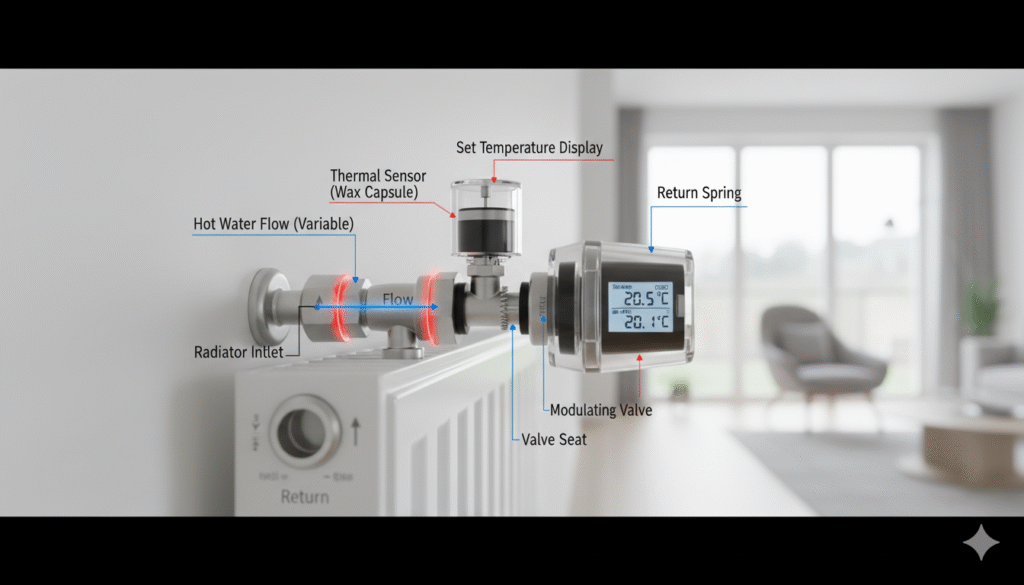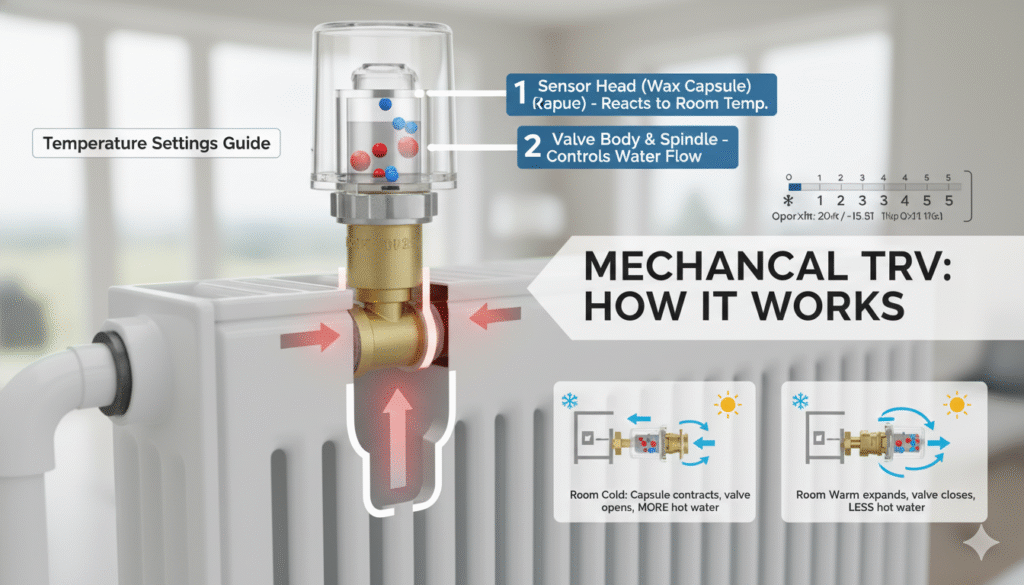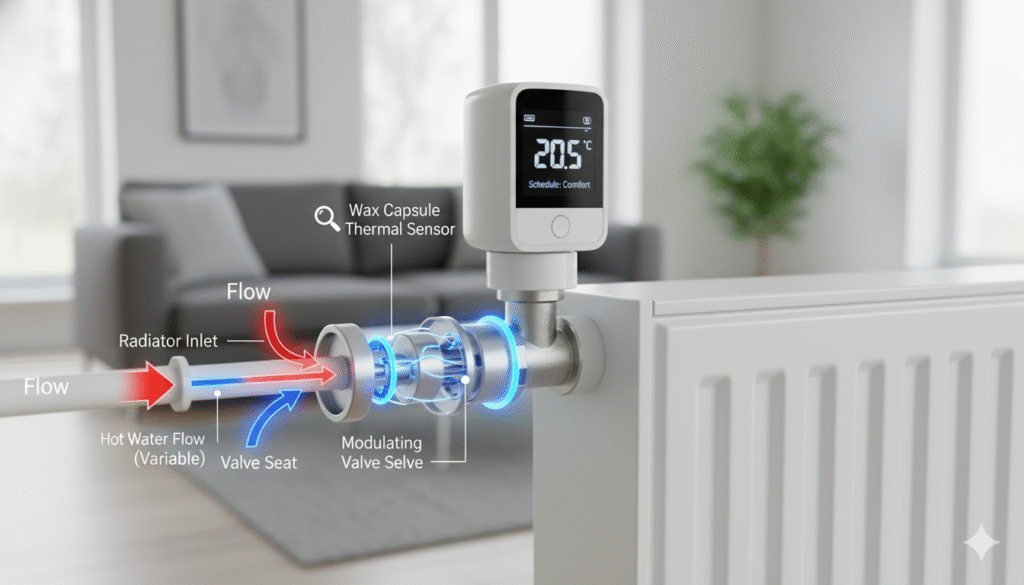TRV – How Thermostatic Radiator Valves Improve Heating Efficiency in 2025
Introduction
Homeowners in the UK are increasingly looking for ways to reduce energy bills and improve central heating efficiency. One simple yet effective solution is installing a TRV – a thermostatic radiator valve. Unlike standard radiator valves, TRVs allow you to control the temperature of each room independently, making your heating system smarter and more energy-efficient.
With the rise of ECO4 heating upgrades and the push toward energy-saving homes, TRVs have become a must-have addition to modern central heating systems. Not only do they improve comfort, but they also contribute to lower carbon emissions, supporting the UK’s environmental goals.
Related keywords: TRV heating control, smart radiator valve, energy-saving radiator valve, ECO4 heating upgrades, central heating efficiency.
What is a TRV?

A TRV (Thermostatic Radiator Valve) is a device attached to a radiator that regulates the flow of hot water depending on the temperature of the room. Traditional manual valves only allow you to control flow at a fixed setting. TRVs, however, adjust automatically to maintain your desired room temperature.
TRVs work by sensing the air temperature near the radiator. If a room reaches the set temperature, the TRV reduces the hot water flow to that radiator, preventing overheating and wasted energy.
Signs you might need TRVs:
- Rooms that overheat while others remain cold.
- High heating bills despite a modern boiler.
- Inconsistent temperatures between floors or zones.
Related keywords: TRV valve, thermostatic valve, radiator controls, radiator temperature control.
Benefits of Installing TRVs
TRVs provide multiple advantages for homeowners looking to improve their heating system efficiency:
- Energy Efficiency
By controlling the room temperature individually, TRVs reduce unnecessary heating. This directly lowers your energy consumption and helps you save on heating bills. - Enhanced Comfort
Every room can have its temperature. For example, bedrooms can be cooler while living areas stay warm, creating a more comfortable home environment. - Support for ECO4 Upgrades
If you are eligible for ECO4 grants, installing TRVs can complement other energy efficiency measures such as new boilers, heat pumps, or insulation. Well-balanced radiators with TRVs ensure maximum benefit from these upgrades. - Extended Boiler Life
TRVs help your boiler operate more efficiently by reducing the load, leading to less wear and tear and a longer lifespan. - Environmental Impact
Using TRVs can reduce your home’s carbon footprint, supporting the UK’s net-zero goals.
Related keywords: energy-efficient heating, smart heating control, save on heating bills, ECO4 heating scheme, TRV benefits.
TRVs and the ECO4 Scheme
The ECO4 scheme is designed to help UK homeowners improve their energy efficiency through heating and insulation upgrades. While TRVs themselves are not usually directly funded by ECO4, they complement ECO4 improvements by optimizing heating systems.
For instance, if you install a new boiler or heat pump under the ECO4 program, adding TRVs ensures that the heat is distributed evenly and efficiently. Properly installed TRVs also make your home more comfortable and help maximize the return on your ECO4-funded upgrades.
Related keywords: ECO4 heating efficiency, ECO4 radiator controls, ECO4 home improvements, energy-saving grants UK.
The Evolution of TRVs – From Mechanical to Smart Connectivity
While the fundamental principle of a TRV has remained consistent for decades, the technology encased within that simple valve has undergone a quiet but profound evolution. We’ve moved beyond purely mechanical devices to a new generation of smart, connected TRVs that integrate seamlessly into the broader ecosystem of a modern smart home.
2.1 The Traditional Mechanical TRV: Reliable Workhorses
For many years, the mechanical TRV, as described in Chapter 1, was the standard. These are robust, entirely self-contained units that require no batteries or external power. Their reliability, ease of installation, and immediate impact on heating control made them a staple in energy-conscious homes and building regulations across many countries. They are fantastic for:
- Zone Control: Allowing different temperatures in different rooms.
- Energy Savings: Preventing overheating in unoccupied or naturally warmer rooms.
- Simplicity: No programming, no apps, just twist and set.
Even today, well-maintained mechanical TRVs remain an excellent choice for straightforward, reliable heating control, especially for those who prefer a “set it and forget it” approach without venturing into smart home tech.

TRVs vs Smart Radiator Valves
Modern TRVs come in two types: standard mechanical TRVs and smart TRVs.Understanding the difference is important when deciding which one to install.
- Standard TRVs
These work mechanically, automatically adjusting water flow based on the air temperature. They are simple, reliable, and relatively inexpensive. - Smart TRVs
These are connected to Wi-Fi and can be controlled via a smartphone app. Some models allow scheduling, geofencing, or integration with smart home systems. Smart TRVs are more expensive but provide better control and convenience.
Choosing between standard and smart TRVs depends on your budget, technical comfort, and whether you want remote control or automation features.
Related keywords: smart TRV, Wi-Fi radiator valve, app-controlled heating, modern radiator controls.
How TRVs Work Step by Step
Understanding how TRVs function can help homeowners use them more effectively:
- Set the Desired Temperature – Most TRVs have numbered settings (1–5) representing different room temperatures.
- Automatic Adjustment – The TRV pin moves according to the air temperature, controlling water flow.
- Room-Specific Heating – Each radiator can maintain a different temperature, depending on the room’s needs.
- Integration with Boilers/Heat Pumps – Works alongside your central heating system for optimized performance.
Costs and Installation
- Standard TRVs: £20–£40 per radiator (DIY-friendly).
- Smart TRVs: £80–£150 per radiator (may require professional installation).
- Professional Installation: If you have multiple radiators or a complex heating system, hiring a heating engineer is recommended.
Installing TRVs is generally straightforward, especially for standard models. For smart TRVs, you may need to pair devices with your home Wi-Fi network or a hub.
Related keywords: TRV installation cost, best TRV UK, affordable radiator valves, TRV installation tips.
The Inner Workings of a TRV – A Masterclass in Simplicity and Ingenuity (Continued)
1.1 The Anatomy of a Mechanical TRV: How It Regulates
To fully grasp the cleverness of a TRV, let’s break down its key components and how they interact:
- The Sensor Head (Thermostatic Element): This is the visible, often cylindrical or conical part you twist to adjust the setting. Inside this head lies the true intelligence of the TRV: a wax capsule or a liquid-filled element. This substance is highly sensitive to temperature changes. As the room temperature rises, the wax or liquid inside expands. As the temperature drops, it contracts.
- The Valve Body: This is the part that’s permanently fitted to your radiator’s inlet pipe, controlling the physical flow of hot water. It contains a valve spindle or pin.
- The Mechanism: The expanding or contracting wax/liquid in the sensor head acts directly on the valve spindle.
- Room Too Cold: The wax/liquid contracts, allowing the spindle to retract (or be pushed open by a spring). This opens the valve, increasing the flow of hot water into the radiator, causing it to heat up.
- Room Reaches Set Temperature: As the room warms up, the wax/liquid expands, pushing the spindle down. This gradually closes the valve, restricting the flow of hot water into the radiator. The radiator then emits less heat, or if completely closed, stops heating altogether.
- Room Too Warm: If the room becomes warmer than the set temperature (perhaps due to sunshine or a roaring fireplace), the valve will close further, or entirely, preventing the radiator from adding more heat.
This continuous, automatic adjustment ensures that each room maintains its desired temperature, independent of other rooms or the central thermostat’s overall setting (though the central thermostat still dictates when the boiler fires up). It’s a localized, responsive system that fundamentally changes how heat is distributed.
1.2 Understanding the Numbers on Your TRV
You’ll notice that most TRVs feature numbers or symbols (often 1-5, or snowflake, 1, 2, 3, 4, 5). These aren’t temperature degrees in Celsius or Fahrenheit, but rather arbitrary settings that correspond to approximate comfort levels:
- Snowflake/Asterisk (*): This is the frost protection setting. It ensures the valve opens slightly if the room temperature drops close to freezing (typically around 5-7°C or 41-45°F) to prevent pipes from freezing, especially in unoccupied rooms during winter.
- Setting 1: Roughly 12-15°C (54-59°F) – A cool, background heat level, good for seldom-used rooms or maintaining a minimal temperature.
- Setting 2: Roughly 16-19°C (61-66°F) – A comfortable temperature for sleeping or moderately used rooms.
- Setting 3: Roughly 20-22°C (68-72°F) – A standard comfortable living temperature for most people.
- Setting 4: Roughly 23-25°C (73-77°F) – A warmer setting, perhaps for a bathroom or if you prefer a significantly warmer environment.
- Setting 5: Generally 26-28°C (79-82°F) – Maximum heat output. It’s often recommended not to leave TRVs on this setting continually as it negates the energy-saving benefits.
It’s important to experiment a little to find the settings that align with your personal comfort in each room. The goal is to set it and forget it, letting the TRV do its work.

Common Issues with TRVs
Like any mechanical device, TRVs can have issues:
- Sticking Pin: Can prevent proper flow adjustment.
- Incorrect Temperature Reading: If the sensor is blocked or too close to furniture.
- TRV Not Working: Sometimes requires replacement.
Regular checks and cleaning can prolong the life of a TRV. If problems persist, a heating engineer can diagnose and fix them efficiently.
Related keywords: TRV not working, TRV maintenance, radiator troubleshooting, radiator repair tips.
Blog Summary Table
| Section | Key Point | Related Keywords |
|---|---|---|
| What is TRV | Controls radiator temperature automatically | TRV, thermostatic valve, radiator controls |
| Benefits | Saves energy, improves comfort, supports ECO4 | energy-efficient heating, smart radiator valve, ECO4 heating scheme |
| ECO4 Scheme | Enhances performance of heating upgrades | ECO4 radiator controls, eco4 home improvements |
| TRVs vs Smart | Smart TRVs offer remote control | smart TRV, Wi-Fi radiator valve, app-controlled heating |
| Costs & Installation | Affordable and easy to install, smart may require pro | TRV installation cost, best TRV UK |
| Common Issues | Pin sticking, temperature misreading | TRV not working, TRV maintenance, radiator troubleshooting |
Conclusion
TRVs are a simple yet highly effective way to improve heating efficiency, reduce energy bills, and support ECO4-funded upgrades. Whether you choose standard TRVs or smart TRVs, these devices allow precise temperature control for every room, making your home more comfortable, energy-efficient, and environmentally friendly.
By installing TRVs, you not only save money but also increase the performance of your heating system, especially after installing new boilers, heat pumps, or insulation upgrades.
Frequently Asked Questions
Find answers to commonly asked questions about our products and services.
